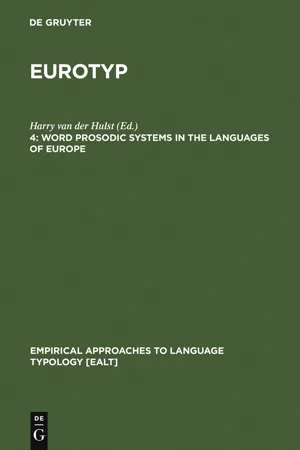
- 1,079 pages
- English
- PDF
- Available on iOS & Android
eBook - PDF
Word Prosodic Systems in the Languages of Europe
About this book
No detailed description available for "Word Prosodic Systems in the Languages of Europe".
Frequently asked questions
Yes, you can cancel anytime from the Subscription tab in your account settings on the Perlego website. Your subscription will stay active until the end of your current billing period. Learn how to cancel your subscription.
At the moment all of our mobile-responsive ePub books are available to download via the app. Most of our PDFs are also available to download and we're working on making the final remaining ones downloadable now. Learn more here.
Perlego offers two plans: Essential and Complete
- Essential is ideal for learners and professionals who enjoy exploring a wide range of subjects. Access the Essential Library with 800,000+ trusted titles and best-sellers across business, personal growth, and the humanities. Includes unlimited reading time and Standard Read Aloud voice.
- Complete: Perfect for advanced learners and researchers needing full, unrestricted access. Unlock 1.4M+ books across hundreds of subjects, including academic and specialized titles. The Complete Plan also includes advanced features like Premium Read Aloud and Research Assistant.
We are an online textbook subscription service, where you can get access to an entire online library for less than the price of a single book per month. With over 1 million books across 1000+ topics, we’ve got you covered! Learn more here.
Look out for the read-aloud symbol on your next book to see if you can listen to it. The read-aloud tool reads text aloud for you, highlighting the text as it is being read. You can pause it, speed it up and slow it down. Learn more here.
Yes! You can use the Perlego app on both iOS or Android devices to read anytime, anywhere — even offline. Perfect for commutes or when you’re on the go.
Please note we cannot support devices running on iOS 13 and Android 7 or earlier. Learn more about using the app.
Please note we cannot support devices running on iOS 13 and Android 7 or earlier. Learn more about using the app.
Yes, you can access Word Prosodic Systems in the Languages of Europe by Harry van der Hulst in PDF and/or ePUB format, as well as other popular books in Languages & Linguistics & Linguistics. We have over one million books available in our catalogue for you to explore.
Information
Table of contents
- Contributors
- Abbreviations
- Part I – Thematic Chapters
- 1 Word accent
- 1.1 Introduction
- 1.2 Basic concepts
- 1.3 Metrical theory
- 1.4 Overview
- 1.5 Accent and tone
- 1.6 Terms, transcriptions and conventions
- 1.7 Concluding remark
- 2 Stress domains
- 2.1 Introduction
- 2.2 The prosodic hierarchy
- 2.3 The mapping of compounds onto prosodic structure
- 2.4 Postlexical word stress readjustments
- 2.5 Conclusions
- 3 The rhythmic organization of compounds and phrases
- 3.1 Introduction
- 3.2 Stress shift and stress strengthening: theoretical background
- 3.3 Bracketed grids: the assignment of stress above the word level
- 3.4 Move x and Add x in English
- 3.5 The case of Dutch: a comparison with English
- 3.6 Language sketches
- 3.7 Summary and conclusions
- 4 Word prosody and intonation
- 4.1 Introduction
- 4.2 Lexical and postlexical tones
- 4.3 Intonation and secondary stress
- 4.4 Summary and conclusions
- 5 The phonetic manifestation of word stress
- 5.1 The phonetic manifestation of word stress in Lithuanian, Polish and German and Spanish
- 5.2 The phonetic manifestation of stress in Welsh
- 6 Diachronic prosody
- 6.1 Introduction
- 6.2 Common Germanic
- 6.3 West Germanic
- 6.4 North Germanic
- 6.5 Typology of Germanic quantity shift
- 6.6 Development of tonal accents
- 6.7 Romance loans
- 6.8 Romance
- 6.9 Summary of types of changes in metrical systems
- Part II – Case Studies
- 7 A survey of word prosodic systems of European languages
- 7.1 Introduction
- 7.2 Language summaries
- 7.3 Classification by type
- 8 Word-stress in West-Germanic and North-Germanic languages
- 8.0 Introduction
- 8.1 Word stress in West-Germanic languages
- 8.2 Word stress in North-Germanic languages
- 9 Word tone in Germanic languages
- 9.1 Scandinavian languages
- 9.2 A description of tonal accent in a Limburgian dialect
- 10 Stress in the Romance languages
- 10.1 Introduction
- 10.2 Syllable windows and extrametricality
- 10.3 Closed syllables
- 10.4 Verbs
- 10.5 Interaction with morphology
- 10.6 Summary and conclusions
- 11 Slavic languages
- 11.1 West Slavic
- 11.2 South Slavic
- 11.3 Russian
- 11.3 Introduction
- 12 Baltic languages
- 12.1 Introduction
- 12.2 Lighuanian
- 12.3 Latvian
- 13 Greek word accent
- 13.1 Introduction
- 13.2 The parameters
- 13.3 Unstressed, underived and uninflected words
- 13.4 Adjectives
- 13.5 Nouns
- 13.6 The verb
- 13.7 The clitics
- 13.8 Dialectal variation of the verb
- 13.9 Prefixing
- 13.10 Compounds
- 13.11 Summary and conclusions
- 14 Basque accentuation
- 14.1 Introduction
- 14.2 The Western type
- 14.3 The Central type
- 14.4 The Hondarribia type
- 14.5 The Northern High Navarrese type
- 14.6 The Southern High Navarrese type
- 14.7 The Labourdin/Low Navarrese type
- 14.8 The Souletin/Roncalese or Eastern type
- 14.9 Summary and conclusions
- 15 Caucasian: Daghestanian languages
- 15.2 Examples arranged according to family and prosodic type
- 15.3 Conclusion
- Index of authors
- Index of languages
- Index of subjects